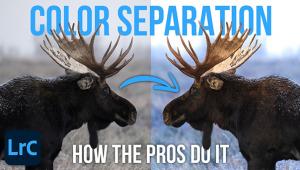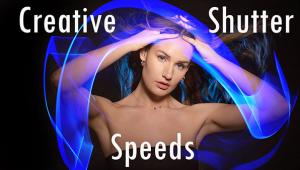Nikon’s D2Xs; A Sporty, Speedy Pro SLR Upgrade Page 2
Auto ISO, Pro Style
Wedding and event photographers often have to work in quickly changing lighting
conditions. This can mean shifting ISO on the run, and while most of us would
notice when we run out of light and thus have to go up in sensitivity, many
of us often forget to shift back to a lower ISO when we go from dark to light,
resulting in less than best image quality in outdoor shots. Borrowing what must
be a feature of or at least an inspiration from point-and-shoot digicams, the
D2Xs has an Auto ISO feature that allows you to set a specific shutter speed
and then will set the ISO in accordance with the light sensitivity needed, at
least up to ISO 800. It's a new kind of Exposure mode that adds a wrinkle
to Shutter-Priority in that it brings not only aperture but also ISO settings
into the mix. Pretty cool.
Speaking of ISO settings, the D2Xs can be set manually between ISO 100 and 800,
and then in increments all the way to ISO 3200 (HI-2). You can do this via the
menu controls or, better, via the ISO button on the back of the camera. It seems
like there is always some NR (Noise Reduction) going on in the background, but
you do have some control as to when it kicks in and, to a certain extent, how
much occurs. If you go into the shooting menu there are two NR areas, one for
long exposures (you have a choice of on or off) and the other for High ISO.
The default is On, where NR occurs when the ISO setting is from 400-800 or at
ISO 400 or higher when ISO Auto is set. The On (high) setting increases NR filtration.
There is also an Off setting that will eliminate NR in all cases except images
exposed over ISO 800. I would suggest keeping NR on in high ISO setups and checking
it out if you really need it in the ISO 400 range. High NR will make images
look a bit softer--that's the tradeoff for losing that static and
electronic graininess.
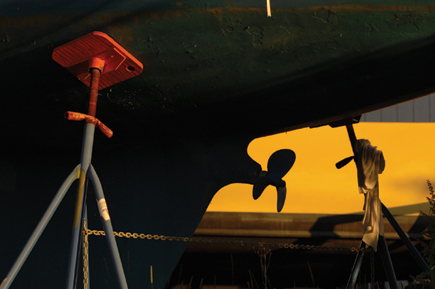 |
|
|
Color And B&W
Being a pro camera the D2Xs is obsessed with color spaces, modes, white balance
options, temperature shifts, etc. This might be overkill for an amateur model,
but after a while you begin to appreciate this attention to detail and think
about how these aids would be used in the studio or on location where color
must be just right. The camera also allows for very nuanced changes in sharpness,
contrast, and saturation, and banks all these in memory. The cool thing is that
the D2Xs now allows you to Rename the Banks (four in total) so you don't
need a cheat sheet every time you pick up the camera. This is done via a keypad/toggle
button operation, a bit labor intensive but not something you'll be doing
often.
What's new in the Recording mode department is the ability to shoot in
black and white, essentially a desaturated sRGB file. Of course you can shoot
in raw or even JPEG and convert easily enough later, but some folks just like
shooting and seeing the instant review in black and white in the field. Puts
them in the mood. And, if there's a change of heart and the shots are
in raw they can be converted back to color later in the Nikon Capture software
(but not in ACR).
Another file manipulation feature is the ability to re-size both raw and JPEG
images right in the camera, which end up being copies of the original. This
feature might preclude the need to shoot raw+JPEG if you do so for full-size
and e-mailable images made in camera. But there are other reasons to do this
dual capture so this setting can still be valuable, depending on how you like
to work.
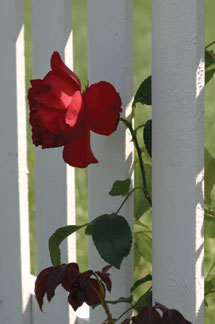 |
|
|
CSI
If you get the feeling that this is essentially a pro studio and location camera,
and especially a sports, action, and even wedding photographer's camera,
you're not far off. One area we don't talk about much is law enforcement
and forensic work, an area that Nikon has always been strong in. Giving more
than a nod to CSI types, the camera and an accompanying software can be used
for Image Authentication, which means it shows when and if the image has been
messed with since original capture.
But there is something for everyone. For those who like to work remotely there's
a new software dubbed Camera Control Pro that can work tethered to a computer
via USB or via an optional WT-2A wireless transmitter. There's also a
built-in intervalometer, for those who enjoy getting shots over a period of
time, sort of like a water sprinkler timer.
By now we've come to expect our digital SLRs to deliver good results and
our pro digital SLRs to deliver outstanding results. There's little debate
that the D2Xs is an outstanding pro camera that lets you do just about whatever
you want with an image, including overlays and multi-exposures right in the
camera. At about $4700 list it is sure to have limited appeal to the D70s (and
new D80) shooter and will not tempt everyone to upgrade anytime soon. It is
a professional camera that seems to have included features and functions that
can appeal to a broad range of pros--with its near-obsessive color controls
for studio and portrait photographers; its blazing speed for sports and action
shooters; its power supply for location and travel shooters; and its CSI capabilities
for law enforcement departments. Perhaps the D2Xs is recognition that a camera,
like the pro who uses it, is not so easily categorized these days.
For the working professional who can use its many attributes and who is tapped
into the Nikon system of lenses and accessories it is state of the art, and
should remain so for some time to come.
Nikon's 105mm f/2.8G ED-IF AF-S VR Micro-Nikkor Lens
For our tests with the D2Xs we worked with the new Nikon 105mm Micro-Nikkor
VR lens. The Angle Of View (AOV) on the camera with this lens is equivalent
to a 35mm format AOV of about 158mm, making it a fast macro/portrait lens as
well as a fast moderate tele for general shooting. We've long been fans
of 105mm Micro-Nikkor lenses in their various mounts and manifestations, it
usually being one of the lens stars of the Nikon line. This one is no exception
and lives up to the 105mm Micro-Nikkor legacy. The treat is that it can be used
on full-frame 35mm Nikon cameras as well.
 |
The VR (Vibration Reduction) feature makes it quite versatile for all shooting, but particularly for macro photography, where every f/stop counts. Nikon claims that using VR yields a 3-4 stop gain, and we found shooting around 1¼15 sec with VR on yielded quite steady images. Combine a fast constant aperture of f/2.8, VR, and macro (1:1) capability together and you've got a heck of a lens. It's also got a 1 ED glass element and a 1 "nano-crystal coat" deposited lens, and a Silent Wave motor, their first macro with same. Heck, we even used it on our polo shots, and standing on the sidelines got us close enough in using High-Speed Crop mode that we didn't even consider switching to another fast tele. It's a gem, and at about $799 well worth the price.
SanDisk's Extreme IV CompactFlash Card (And Reader): Fast Read
And Write For Hot Digicams
Our test of the Nikon D2Xs was enhanced by use of the new SanDisk Extreme IV
CompactFlash card and reader. The new card/reader represents the next generation
of CompactFlash in terms of speed in read and write times. We really saw how
well this worked when downloading a bit over 700MB of images from our sports
shots made with the D2Xs to our Apple MacBook Pro. Rated by the maker at 40MB
per second read and write speed, we downloaded 716MB of images from a 2GB Extreme
IV card using the reader in about 18 seconds.
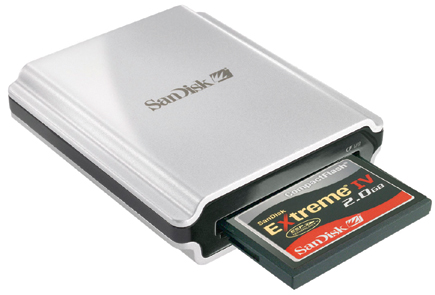 |
There was also no problem for the card in keeping up with even the 8 fps recording
rates I used in High-Speed Crop mode, even with a few second bursts. Our testing
showed that the card will take even the fastest processing speeds available
today, and anticipates even faster recording rates that might be coming down
the pike. Those who have worked with standard cards will see a dramatic improvement
in download times, while those working with even fast cards of the previous
generation will see a 100 percent gain.
According to the company, their new speed ratings nearly doubles performance
of the Extreme III line, introduced in 2004. But digital SLRs like the D2Xs
are but one beneficiary of the newfound read and write speed. The company points
to medium format digital cameras and backs, such as the Hasselblad H2D-39 and
Leaf Aptus family, as showing great gains. These units produce what they dub
as "enormous" files that must be processed quickly in the heat of
a shoot.
The new generation of cards is available in 2, 4, and 8GB capacities, and will
show the improved speed when used with the compact SanDisk 800/400 card reader.
To sweeten the pot the company is bundling the new cards and reader at intro
pricing, plus throws in a 30-day trial version of Adobe's Photoshop CS2.
The reader will be available in both FireWire and USB 2.0 patches. Prices are
available on the company's website at: www.sandisk.com.
The Intro pack of 4GB card and reader goes for $319.99.
Lensbaby 3.0
Part of our shooting time with the Nikon D2Xs was spent working with the then
hush-hush Lensbaby 3.0. Given that it was still in prototype form it performed
quite well and yielded the usual Lensbaby image kicks. But when we first heard
about this new Lensbaby we thought the company had gone straight.
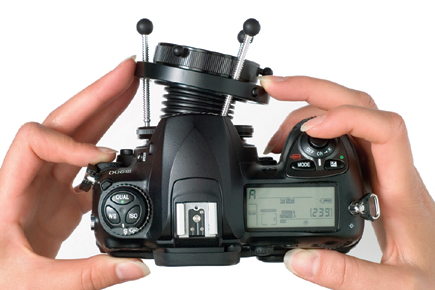 |
The Original Lensbaby and 2.0 always delivered a fairly unpredictable outcome,
or at least fairly unrepeatable results. You squeezed and tilted the bellows/lens
arrangement into a shape that you would be hard-pressed to match for the next
shot. But the difference between this and other screw-in type aberration lenses
was that the quality of the glass in these manifestations was quite good, and
the cult grew.
Apparently some folks--studio and portrait types--requested that the
Lensbaby folks create an item with the same features but with a design that
allowed them to hold the odd planes of focus from one shot to the next. The
result is the amazing piece of engineering known here as Lensbaby 3.0. The illustration
shows the prototype, which we trust will be changed in the final form. In essence,
you do your twist thing and then click a small switch in an indent, which locks
the positioning via the three screw rods. To release the setup you press the
two small knobs together and it goes back to where it started. And, get this,
you can perform fine focus with a lens collar on the inset.
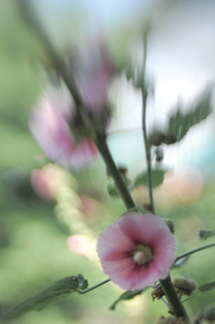 |
|
|
So, have they gone too straight to keep the Lensbaby cult alive? It's
still quirky enough to keep that from happening, and this manifestation should
make the following grow even more. It will be available in various SLR lens
mounts at a price that was not available at press time.
For more information, visit the Lensbabies website at: www.lensbabies.com.
For full Technical Specifications, visit the Instant Links section of the Shutterbug
website (www.shutterbug.com/currentissuelinks/)
to gain access to the relevant Nikon web page or visit www.nikonusa.com.
For more information, contact Nikon Inc., 1300 Walt Whitman Rd., Melville, NY
11747; (800) 526-4566, (631) 547-4200; www.nikonusa.com.
- Log in or register to post comments


























